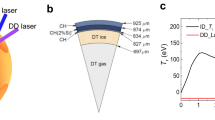Abstract.
The high compression of 600 times liquid density and the recent fast heating of a compressed core to 1-keV temperature have provided proof-of-principle of the fast ignition concept, and these results have significantly contributed to approve first phase of the Fast Ignition Realization EXperiment (FIREX) project. The goal of FIREX-I is to demonstrate fast heating of a fusion fuel up to the ignition temperature of 5–10 keV. Although the fuel size of FIREX-I is too small to ignite, sufficient heating will provide the scientific viability of ignition-and-burn by increasing the laser energy thereby the fuel size. Based on the result of FIREX-I, the decision of the start of FIREX-II to achieve ignition-and-burn can be made. The FIREX program is under the collaboration of the Institute of Laser Engineering and the National Institute for Fusion Science.
Similar content being viewed by others
References
O. Motojima et al., Nucl. Fusion 45, S255 (2005)
A. Komori et al., Phys Plasmas 45, 056122 (2005)
R. Kumazawa et al., Nucl. Fusion 46, S13 (2006)
S. Imagawa et al., IEEE Trans. Appl. Supercond. 14, 1388 (2004)
Y. Hishinuma et al., IEEE Trans. Appl. Supercond, 14, 1435 (2004)
A. Sagara et al., Nucl. Fusion 45, 258 (2005)
Joint Report of EU/JA Expert Group Meeting 18th/19th April 2004, Culham on A broader Approach to on A Broader Approach to Fusion Power (ITER)
T. Yamanaka, “Enhanced heating by psec laser pulse”, Experimental Proposals for Kongoh Project Phase I, Institute of Laser Engineering Internal Report, Osaka University, May 1983, pp. 5, 6
N. Basov, J. Sov. Laser Res. 13, 396 (1992)
M. Tabak, Phys. Plasmas 1, 1626 (1994)
R. Kodama et al., Nature 418, 933 (2002)
R. Kodama et al., Nucl. Fusion 44, S276 (2004)
S. Fujioka et al., Phys. Rev. Lett. 92, 195001 (2004); S. Fujioka et al., Phys. Plasmas 11, 2814 (2004)
H. Azechi et al., Laser Part. Beam 9, 193 (1991)
N. Miyanaga et al., Inertial Fusion Science and Applications 2003, edited by B.A. Hammel, D.D. Meyerhofer, J. Meyer-ter-Vehn, and H. Azechi (American Nuclear Society, Illinois, 2004), p. 507
T. Shoji, S. Tokita, J. Kawanaka, M. Fujita, Y. Izawa, Jpn J. Appl. Phys. 43, L496 (2004)
T. Norimatsu, K. Nagai, T. Yamanaka, in Fusion Energy 2004 (International Atomic Energy Agency, Vienna, 2001), IFP_07
K. Tomabechi et al., J. Phys. IV France 133, 791 (2006)
Author information
Authors and Affiliations
Corresponding author
Rights and permissions
About this article
Cite this article
Motojima, O. Review of Japanese fusion program and role of inertial fusion. Eur. Phys. J. D 44, 219–225 (2007). https://doi.org/10.1140/epjd/e2007-00196-3
Received:
Published:
Issue Date:
DOI: https://doi.org/10.1140/epjd/e2007-00196-3




